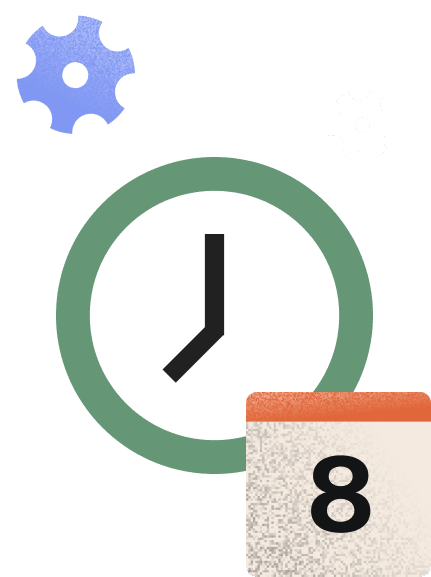Learn how to implement block scheduling for your business so you can take control of your time and work more efficiently.

What does your average hour look like in your work day? You might reply to an Instagram story, adjust the logo you’re working on for a client, then read an email while looking at office supplies on Amazon. Finally, you reply to the email after re-reading it since you forgot the details.
If you’re anything like most Independent business owners, you switch between a wide variety of tasks each hour.
Sadly, research shows that context switching (switching between different types of tasks) kills productivity, focus, and attention span.
That’s why block scheduling, or time blocking, is so powerful.
When you use block scheduling for work, you plan out chunks of your time to work on one specific task or one project at a time. This allows you to pay attention to the task at hand and do it with more focus rather than being distracted.
Here’s how you can easily use block scheduling throughout your workweek.
Jump to:
- What does block scheduling look like at work?
- How to implement block scheduling
- The benefits of a block schedule for work
What does block scheduling look like at work?
Block scheduling not only helps you prioritize your tasks, but also gives you the time to solve problems, complete more focused work, and get stuff done.
Instead of looking at your to-do list every day and cherry-picking what you’ll accomplish, block scheduling assigns a specific block of time for each task. This gives you the space you need to work while also holding you accountable to focus on each priority.
With block scheduling, you’ll have better time management and ownership of your own time. You can make sure that clients only book meetings with you at set times and that your employees know when it’s the best time to share what they’re working on. It can also help you create a better work-life balance and allow you to set aside more personal time.
How to implement block scheduling
Implementing a block schedule for work is simple. All you need is a calendar tool or meeting scheduler to get started. From there, you can build out your blocks of time by day and week. Depending on how you like to work, you can build a set daily schedule, weekly schedule, or custom schedule.
Pro tip
Not sure how to break up your schedule efficiently? Use a freelancer time tracking app to see exactly how you spend your time.
Each block is an amount of time that you’ll devote to a specific task or project. For instance, you might block your Monday mornings for deep work catching up on project work, or use that time to answer emails that came in over the weekend.
Here’s one example of a block schedule for work that stays consistent from week to week:
| Monday | Tuesday | Wednesday | Thursday | Friday | |
| 9:00 – 10:00 am | Emails | Emails | Emails | Emails | Emails |
| 10:00 – 11:00 am | Consultations | Consultations | Consultations | Consultations | Consultations |
| 11:00 – 12:00 pm | Business Work | Business Work | Business Work | Business Work | Task Catch-Up |
| 12:00 – 1:00 pm | Lunch | Lunch | Lunch | Lunch | Lunch |
| 1:00 – 2:00 pm | Project Tasks | Project Tasks | Project Tasks | Project Tasks | Client Meetings |
| 2:00 – 3:00 pm | Client Meetings | Client Meetings | Client Meetings | Client Meetings | Client Meetings |
| 3:00 – 4:00 pm | Break Time & Emails | Break Time & Emails | Break Time & Emails | Break Time & Emails | Break Time & Emails |
| 4:00 – 5:00 pm | Task Catch-Up | Team Meeting | Accounting Sync | Creative Brainsorming | Creative Brainstorming |
Pro tip
Use HoneyBook’s scheduling tool to block off time for initial consultations and client meetings. When you send your link, leads and clients will only be able to choose from your set time blocks.
Follow the steps below to determine what should go into your block scheduling system.
1. Plan time to work on your business
Your first instinct every day might be to answer emails or move your client projects forward, but the first thing you prioritize should be work on your business. That doesn’t mean ignoring all the other stuff – it just means you should block your business time during the hours when you’re the most productive, so it gets your best attention and focus.
This work could be anything from marketing and sales to setting up your automations, contracts, and proposals. Essentially, any work that requires your leadership and strategy. You can use a clientflow platform like HoneyBook to help streamline all of this work and help make it easier to grow your business.
2. Set fixed times when you reply to emails
Although some messages are important, you’re ruled by other people’s schedules when you check your email all day. Your clients get to decide when you should pay attention, and you end up spending the entire day reacting instead of acting.
So why not eliminate the distraction and set aside time to read and reply to your email twice a day? You’ll be able to concentrate much better for the rest of the day. You can use timeboxing to set a certain amount of time toward your emails each day or week.
For emails that need a timely response, like new inquiries, you can use automations. That way, you can ensure you’re delivering a prompt response when clients expect it without taking more time away from you.
3. Schedule your breaks.
Refueling and getting refreshed are important if you want to do great work throughout the day – so schedule when you will actually prepare and eat lunch.
Sometimes we’re prone to thinking breaks make us less productive, but it’s actually the opposite. Breaks have been proven to increase productivity. They help us problem-solve and feel more energized. They’re also a good time to indulge in activities that otherwise might waste our time while we’re working, like checking social media or catching up on the news.
4. Look at where all of your client projects are, and what needs to happen
Now, block out a chunk of time to work on your client projects. I like to work on projects in two or four-hour increments, but you can experiment and see what works for you.
Depending on what you do, you could also add deliverables to each block that should be completed after the block is over.
5. Make a list of everything that is leftover from this week or prior
Schedule all your leftover tasks next. If there are a lot of small tasks left over, consider scheduling a power hour to work on knocking all of them out in one go. Make sure you have a list of everything that needs to happen so it’s easy to just move through each task.
Related Post
7 time management strategies for business owners
The benefits of using a block schedule for work
Time blocking for work will help you stay more organized and focused than a traditional schedule, and it can also ensure you’re completing everything you need to throughout your workweek.
Block scheduling also gives you the mental space to actually focus on enjoying your time off work. Not only will it help you increase your personal and business productivity, but the sense of control of your time makes your clients, family, and employees much happier too!

Skip the back-and-forth: Schedule meetings, sessions, consultations, and more in one click.




